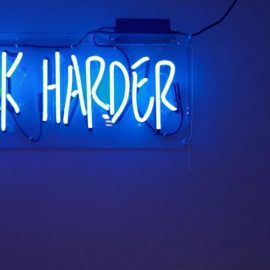

This article is an excerpt from the Shortform book guide to "Cues" by Vanessa Van Edwards. Shortform has the world's best summaries and analyses of books you should be reading.
Like this article? Sign up for a free trial here.
Do you want to develop a memorable personal brand? What visual cues can you use to influence others’ perceptions of you?
Developing a charismatic brand involves more than just your words and actions. It’s about curating your visual presence to create specific associations in people’s minds. This includes your wardrobe choices, color preferences, and the imagery you use in professional settings.
Read on for some practical tips from Vanessa Van Edwards for crafting a unique and impactful personal brand that resonates with your audience.
Creating a Charismatic Brand
In addition to using your speech and behavior, Van Edwards says you can influence how others perceive you by manipulating visual cues to concoct a unique-to-you charismatic brand that brings to mind certain associations. Your personal brand includes factors such as your wardrobe, the colors you surround yourself with, and the imagery you use in professional contexts.
(Shortform note: Another factor to consider is how effortful your personal brand seems. According to Patrick King (Read People Like a Book), people who don’t put much effort into how they look seem less confident (and therefore less competent). However, in some contexts, a seemingly effortless appearance is more charismatic. For example, effortless fashions and “no-makeup” makeup looks are currently en vogue.)
Let’s explore Van Edwards’s tips for developing a charismatic brand for yourself:
Curate your wardrobe. You can use your choice of clothing and accessories to signal warmth and competence in different measures. For example, if you always wear athleisure, others may subconsciously associate you with energy and vitality (competence cues) and see you as more approachable (a warmth cue) than someone who’s always dressed formally. Van Edwards suggests matching your wardrobe to the stereotypes whose associations you wish to embody, but she also notes that breaking the mold can be impactful because unexpected attire grabs others’ attention.
(Shortform note: CEOs often make distinctive wardrobe choices that help them stand out and convey specific attributes. For example, in Steve Jobs, Walter Isaacson details how the Apple executive curated his personal brand by making a unique wardrobe choice—he always wore a black mock turtleneck designed by Issey Miyake in public appearances, which conveyed both simplicity and elegance and signaled that Jobs had more important concerns than his wardrobe. Similarly, in Trailblazer, Salesforce CEO Marc Benioff explains that he often wears Hawaiian shirts—a relaxed, easygoing style choice that matches the progressive, wellness-focused image his company projects.)
Consider color. Van Edwards contends that a few colors—red, yellow, green, and blue—have meanings that are nearly universal. You can use these colors strategically in your wardrobe, decor, presentations, and in other contexts to help others perceive you in a specific way.
- Red is associated with rushes of blood, which can convey excitement, danger, or urgency, so you can use it to attract attention. (Shortform note: Wearing red may also make you seem more confident because it communicates political and sexual prowess.)
- Yellow is associated with sunlight and can evoke happiness, but it works best in small doses because it can strain the eyes. (Shortform note: Saturated colors cause the most eyestrain, so you may be able to get away with larger amounts of pale or pastel yellow.)
- Green is associated with nature, so you can use it to signal environmentalism and good health. (Shortform note: Where currency is green, the color is also associated with money, which is why many financial institutions use green in their branding.)
- Blue is associated with tranquil skies and bodies of water, so it makes people feel at ease, which can help them focus. (Shortform note: In Blue Mind, Wallace J. Nichols argues that blue is also associated with cleanliness, trust, wisdom, and strength.)
Use imagery associated with competence and warmth in professional contexts. For example, if you’re a therapist, you might stock your office with both reference books and comforting decor like art and plants to elicit clients’ trust in your services. Similarly, in remote work contexts, you can use imagery to curate your online presence and your background in video calls to convey the ideal mix of competence and warmth cues. Van Edwards explains that some clients will respond better to warmth cues than competence cues or vice versa—so you can tailor the imagery you use according to the clients you’d like to attract.
(Shortform note: Your ability to use certain kinds of imagery may be shaped by legal, cultural, or professional expectations. For example, to be more inclusive of all the people you serve professionally, you may want to avoid using politically or religiously divisive imagery. In some contexts (like in the US public school system), you may be legally mandated to avoid using such imagery; in other contexts, you may be able to use such imagery to weed out clientele you don’t want to serve (as is the case for pro-Donald Trump stores). Similarly, while it may be appropriate for a children’s therapist to stock their office with cartoonish art and games, that probably wouldn’t be appropriate for a therapist who only sees adults.)

———End of Preview———
Like what you just read? Read the rest of the world's best book summary and analysis of Vanessa Van Edwards's "Cues" at Shortform.
Here's what you'll find in our full Cues summary:
- Which verbal and nonverbal cues will make you more charismatic
- How to make yourself seen in your professional and social lives
- Why head tilts are cuter in dogs than in humans






